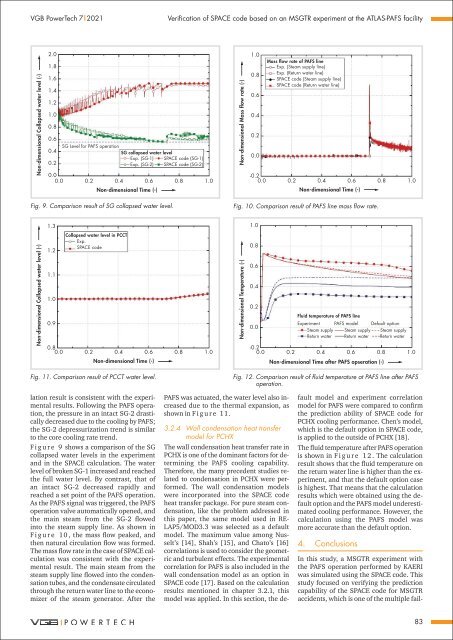VGB POWERTECH 7 (2021) - International Journal for Generation and Storage of Electricity and Heat
VGB PowerTech - International Journal for Generation and Storage of Electricity and Heat. Issue 7 (2021). Technical Journal of the VGB PowerTech Association. Energy is us! Optimisation of power plants. Thermal waste utilisation.
VGB PowerTech - International Journal for Generation and Storage of Electricity and Heat. Issue 7 (2021).
Technical Journal of the VGB PowerTech Association. Energy is us!
Optimisation of power plants. Thermal waste utilisation.
- No tags were found...
You also want an ePaper? Increase the reach of your titles
YUMPU automatically turns print PDFs into web optimized ePapers that Google loves.
<strong>VGB</strong> PowerTech 7 l <strong>2021</strong><br />
Verification <strong>of</strong> SPACE code based on an MSGTR experiment at the ATLAS-PAFS facility<br />
Non-dimensional Collapsed water level (-)<br />
2.0<br />
1.8<br />
1.6<br />
1.4<br />
1.2<br />
1.0<br />
0.8<br />
0.6<br />
SG Level <strong>for</strong> PAFS operation<br />
0.4<br />
SG collapsed water level<br />
Exp. (SG-1) SPACE code (SG-1)<br />
0.2<br />
Exp. (SG-2) SPACE code (SG-2)<br />
0.0<br />
0.0 0.2 0.4 0.6 0.8 1.0<br />
Non-dimensional Time (-)<br />
Non-dimensional Mass flow rate (-)<br />
1.0<br />
0.8<br />
0.6<br />
0.4<br />
0.2<br />
0.0<br />
Mass flow rate <strong>of</strong> PAFS line<br />
Exp. (Steam supply line)<br />
Exp. (Return water line)<br />
SPACE code (Steam supply line)<br />
SPACE code (Return water line)<br />
-0.2<br />
0.0 0.2 0.4 0.6 0.8 1.0<br />
Non-dimensional Time (-)<br />
Fig. 9. Comparison result <strong>of</strong> SG collapsed water level.<br />
Fig. 10. Comparison result <strong>of</strong> PAFS line mass flow rate.<br />
1.3<br />
1.0<br />
Non-dimensional Collapsed water level (-)<br />
1.2<br />
1.1<br />
1.0<br />
0.9<br />
Collapsed water level in PCCT<br />
Exp.<br />
SPACE code<br />
0.8<br />
0.0 0.2 0.4 0.6 0.8 1.0<br />
Non-dimensional Time (-)<br />
Non-dimensional Temperature (-)<br />
0.8<br />
0.6<br />
0.4<br />
0.2<br />
0.0<br />
Fluid temperature <strong>of</strong> PAFS line<br />
Experiment PAFS model Default option<br />
Steam supply Steam supply Steam supply<br />
Return water Return water Return water<br />
-0.2<br />
0.0 0.2 0.4 0.6 0.8 1.0<br />
Non-dimensional Time after PAFS opseration (-)<br />
Fig. 11. Comparison result <strong>of</strong> PCCT water level.<br />
Fig. 12. Comparison result <strong>of</strong> fluid temperature at PAFS line after PAFS<br />
operation.<br />
lation result is consistent with the experimental<br />
results. Following the PAFS operation,<br />
the pressure in an intact SG-2 drastically<br />
decreased due to the cooling by PAFS;<br />
the SG-2 depressurization trend is similar<br />
to the core cooling rate trend.<br />
F i g u r e 9 shows a comparison <strong>of</strong> the SG<br />
collapsed water levels in the experiment<br />
<strong>and</strong> in the SPACE calculation. The water<br />
level <strong>of</strong> broken SG-1 increased <strong>and</strong> reached<br />
the full water level. By contrast, that <strong>of</strong><br />
an intact SG-2 decreased rapidly <strong>and</strong><br />
reached a set point <strong>of</strong> the PAFS operation.<br />
As the PAFS signal was triggered, the PAFS<br />
operation valve automatically opened, <strong>and</strong><br />
the main steam from the SG-2 flowed<br />
into the steam supply line. As shown in<br />
F i g u r e 10 , the mass flow peaked, <strong>and</strong><br />
then natural circulation flow was <strong>for</strong>med.<br />
The mass flow rate in the case <strong>of</strong> SPACE calculation<br />
was consistent with the experimental<br />
result. The main steam from the<br />
steam supply line flowed into the condensation<br />
tubes, <strong>and</strong> the condensate circulated<br />
through the return water line to the economizer<br />
<strong>of</strong> the steam generator. After the<br />
PAFS was actuated, the water level also increased<br />
due to the thermal expansion, as<br />
shown in F i g u r e 11 .<br />
3.2.4 Wall condensation heat transfer<br />
model <strong>for</strong> PCHX<br />
The wall condensation heat transfer rate in<br />
PCHX is one <strong>of</strong> the dominant factors <strong>for</strong> determining<br />
the PAFS cooling capability.<br />
There<strong>for</strong>e, the many precedent studies related<br />
to condensation in PCHX were per<strong>for</strong>med.<br />
The wall condensation models<br />
were incorporated into the SPACE code<br />
heat transfer package. For pure steam condensation,<br />
like the problem addressed in<br />
this paper, the same model used in RE-<br />
LAP5/MOD3.3 was selected as a default<br />
model. The maximum value among Nusselt’s<br />
[14], Shah’s [15], <strong>and</strong> Chato’s [16]<br />
correlations is used to consider the geometric<br />
<strong>and</strong> turbulent effects. The experimental<br />
correlation <strong>for</strong> PAFS is also included in the<br />
wall condensation model as an option in<br />
SPACE code [17]. Based on the calculation<br />
results mentioned in chapter 3.2.1, this<br />
model was applied. In this section, the default<br />
model <strong>and</strong> experiment correlation<br />
model <strong>for</strong> PAFS were compared to confirm<br />
the prediction ability <strong>of</strong> SPACE code <strong>for</strong><br />
PCHX cooling per<strong>for</strong>mance. Chen’s model,<br />
which is the default option in SPACE code,<br />
is applied to the outside <strong>of</strong> PCHX [18].<br />
The fluid temperature after PAFS operation<br />
is shown in F i g u r e 1 2 . The calculation<br />
result shows that the fluid temperature on<br />
the return water line is higher than the experiment,<br />
<strong>and</strong> that the default option case<br />
is highest. That means that the calculation<br />
results which were obtained using the default<br />
option <strong>and</strong> the PAFS model underestimated<br />
cooling per<strong>for</strong>mance. However, the<br />
calculation using the PAFS model was<br />
more accurate than the default option.<br />
4. Conclusions<br />
In this study, a MSGTR experiment with<br />
the PAFS operation per<strong>for</strong>med by KAERI<br />
was simulated using the SPACE code. This<br />
study focused on verifying the prediction<br />
capability <strong>of</strong> the SPACE code <strong>for</strong> MSGTR<br />
accidents, which is one <strong>of</strong> the multiple fail-<br />
83


















